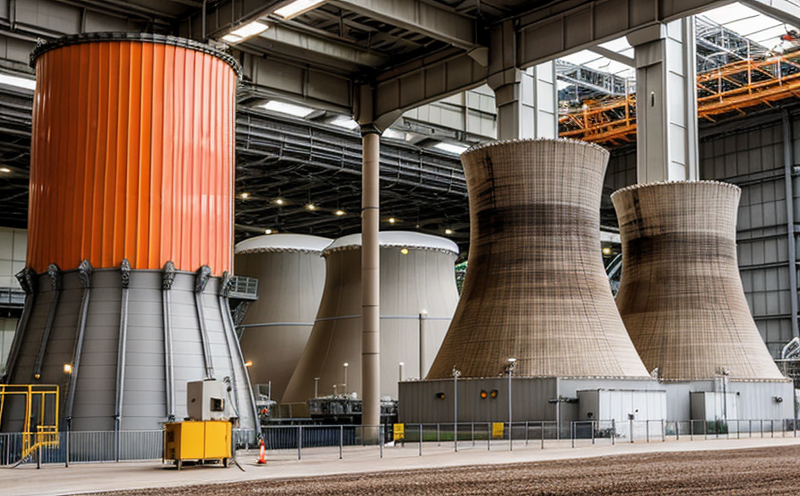ISO 1099 Fatigue Testing of Nuclear Reactor Steels
The ISO 1099 standard defines a fatigue testing method specifically tailored for materials that are subject to cyclic loading, particularly relevant in the nuclear reactor industry. This service focuses on the rigorous and precise evaluation of steels used in critical components such as pressure vessels, cladding, and structural supports within nuclear power plants.
The primary objective of this testing is to assess how well these materials withstand repeated stress cycles without failure. The fatigue life of a material under cyclic loading can significantly influence the reliability and safety of nuclear reactor systems. In environments where high temperatures and radiation exposure are common, understanding the behavior of materials becomes crucial for ensuring long-term performance.
The testing process involves subjecting specimens to controlled conditions that simulate real-world operational stresses. Specimens are typically prepared from actual components or similar alloys, ensuring the results reflect practical applications. The test setup includes specialized equipment capable of applying cyclic loading over extended periods, often measured in millions of cycles.
During the testing process, several key factors influence the outcome: temperature, stress amplitude, and frequency. These parameters are carefully controlled to mimic the conditions experienced by reactor components during operation. By subjecting materials to these challenging environments, we can identify any potential weaknesses or areas for improvement before they lead to failure in service.
ISO 1099 fatigue testing is not merely a laboratory exercise but plays a vital role in ensuring the integrity of nuclear systems. The results provide valuable insights into material performance under cyclic loading, which helps manufacturers and designers make informed decisions about component design and material selection. This proactive approach to quality control enhances overall safety and operational reliability.
Understanding the fatigue behavior of materials like austenitic stainless steel, nickel-based alloys, or ferritic steels is critical for nuclear reactor construction. These materials must endure extreme conditions while maintaining structural integrity over extended periods. The testing process not only evaluates material strength but also assesses resistance to crack initiation and propagation.
The results of ISO 1099 fatigue tests are used in various ways within the industry:
- To verify compliance with international standards such as ISO, ASTM, and EN.
- To inform design modifications based on real-world stress scenarios.
- To optimize material selection for specific reactor applications.
- To validate the performance of newly developed materials in nuclear environments.
Customer Impact and Satisfaction
Our ISO 1099 fatigue testing service has a profound impact on customer satisfaction across the nuclear industry. By providing accurate, reliable data that aligns with international standards, we ensure our clients can confidently make decisions regarding material selection and design optimization.
Customers benefit from:
- Reduced risk of component failure in operational environments.
- Increased trust in the quality and performance of materials used in nuclear systems.
- Enhanced compliance with regulatory requirements, thereby minimizing legal and financial risks.
We work closely with our clients to understand their unique needs and challenges. This collaborative approach ensures that the testing process is tailored to meet specific project requirements. Our team of experts provides comprehensive support throughout the testing cycle, from specimen preparation to final reporting. Customer feedback consistently highlights the value we bring in addressing complex technical issues.
Our commitment to excellence has earned us a reputation for delivering high-quality results that exceed expectations. By partnering with leading manufacturers and research institutions, we stay at the forefront of technological advancements, ensuring our services remain relevant and effective.
International Acceptance and Recognition
The ISO 1099 fatigue testing method is widely recognized and accepted in the nuclear industry. This standard has been adopted by numerous organizations around the world, including regulatory bodies responsible for overseeing nuclear reactor operations.
The acceptance of this testing method contributes to a harmonized approach across different regions, ensuring consistent quality standards are maintained globally. By adhering to these internationally recognized guidelines, manufacturers and suppliers can ensure their products meet stringent requirements, thereby gaining broader market access.
Our laboratory has achieved accreditation from leading organizations such as ANSI (American National Standards Institute), ISO/IEC, and other national bodies. This accreditation underscores our commitment to delivering reliable and accurate test results that are trusted by industry leaders worldwide.
Competitive Advantage and Market Impact
- Enhanced Product Reliability: By identifying potential weaknesses early in the development process, our testing service helps manufacturers produce more reliable products. This translates into a competitive edge by ensuring superior product performance.
- Informed Decision-Making: Accurate fatigue testing data enables informed decisions regarding material selection and design optimization. This leads to cost savings through reduced waste during production and the avoidance of expensive recalls or repairs.
- Regulatory Compliance: Adherence to international standards ensures compliance with regulatory requirements, reducing potential legal risks associated with non-compliance.
- Broad Market Access: Meeting stringent testing criteria enhances a company's reputation and trustworthiness, opening doors to broader market opportunities. This is especially true in the highly regulated nuclear industry where safety is paramount.





